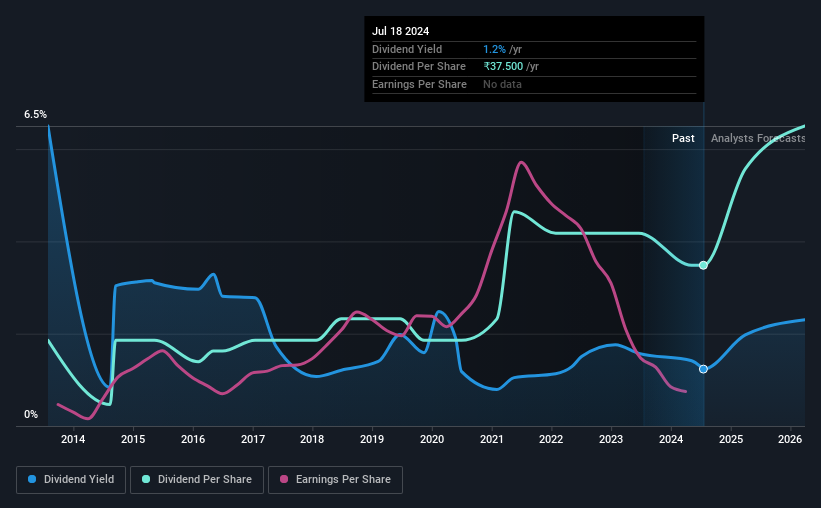- India
- /
- Basic Materials
- /
- NSEI:BIRLANU
Why It Might Not Make Sense To Buy HIL Limited (NSE:HIL) For Its Upcoming Dividend
Some investors rely on dividends for growing their wealth, and if you're one of those dividend sleuths, you might be intrigued to know that HIL Limited (NSE:HIL) is about to go ex-dividend in just 3 days. The ex-dividend date is one business day before a company's record date, which is the date on which the company determines which shareholders are entitled to receive a dividend. The ex-dividend date is of consequence because whenever a stock is bought or sold, the trade takes at least two business day to settle. Meaning, you will need to purchase HIL's shares before the 23rd of July to receive the dividend, which will be paid on the 22nd of August.
The company's upcoming dividend is ₹22.50 a share, following on from the last 12 months, when the company distributed a total of ₹37.50 per share to shareholders. Last year's total dividend payments show that HIL has a trailing yield of 1.2% on the current share price of ₹3041.80. We love seeing companies pay a dividend, but it's also important to be sure that laying the golden eggs isn't going to kill our golden goose! So we need to check whether the dividend payments are covered, and if earnings are growing.
View our latest analysis for HIL
Dividends are typically paid out of company income, so if a company pays out more than it earned, its dividend is usually at a higher risk of being cut. It paid out 81% of its earnings as dividends last year, which is not unreasonable, but limits reinvestment in the business and leaves the dividend vulnerable to a business downturn. It could become a concern if earnings started to decline. Yet cash flow is typically more important than profit for assessing dividend sustainability, so we should always check if the company generated enough cash to afford its dividend. Dividends consumed 51% of the company's free cash flow last year, which is within a normal range for most dividend-paying organisations.
It's positive to see that HIL's dividend is covered by both profits and cash flow, since this is generally a sign that the dividend is sustainable, and a lower payout ratio usually suggests a greater margin of safety before the dividend gets cut.
Click here to see the company's payout ratio, plus analyst estimates of its future dividends.

Have Earnings And Dividends Been Growing?
Businesses with shrinking earnings are tricky from a dividend perspective. If business enters a downturn and the dividend is cut, the company could see its value fall precipitously. With that in mind, we're discomforted by HIL's 18% per annum decline in earnings in the past five years. Such a sharp decline casts doubt on the future sustainability of the dividend.
The main way most investors will assess a company's dividend prospects is by checking the historical rate of dividend growth. HIL has delivered an average of 6.5% per year annual increase in its dividend, based on the past 10 years of dividend payments. That's intriguing, but the combination of growing dividends despite declining earnings can typically only be achieved by paying out a larger percentage of profits. HIL is already paying out 81% of its profits, and with shrinking earnings we think it's unlikely that this dividend will grow quickly in the future.
Final Takeaway
Is HIL an attractive dividend stock, or better left on the shelf? While earnings per share are shrinking, it's encouraging to see that at least HIL's dividend appears sustainable, with earnings and cashflow payout ratios that are within reasonable bounds. With the way things are shaping up from a dividend perspective, we'd be inclined to steer clear of HIL.
Although, if you're still interested in HIL and want to know more, you'll find it very useful to know what risks this stock faces. For example, we've found 3 warning signs for HIL that we recommend you consider before investing in the business.
If you're in the market for strong dividend payers, we recommend checking our selection of top dividend stocks.
Valuation is complex, but we're here to simplify it.
Discover if BirlaNu might be undervalued or overvalued with our detailed analysis, featuring fair value estimates, potential risks, dividends, insider trades, and its financial condition.
Access Free AnalysisHave feedback on this article? Concerned about the content? Get in touch with us directly. Alternatively, email editorial-team (at) simplywallst.com.
This article by Simply Wall St is general in nature. We provide commentary based on historical data and analyst forecasts only using an unbiased methodology and our articles are not intended to be financial advice. It does not constitute a recommendation to buy or sell any stock, and does not take account of your objectives, or your financial situation. We aim to bring you long-term focused analysis driven by fundamental data. Note that our analysis may not factor in the latest price-sensitive company announcements or qualitative material. Simply Wall St has no position in any stocks mentioned.
Have feedback on this article? Concerned about the content? Get in touch with us directly. Alternatively, email editorial-team@simplywallst.com
About NSEI:BIRLANU
BirlaNu
Engages in the production and distribution of building materials and other solutions in India and internationally.
Undervalued with moderate growth potential.
Similar Companies
Market Insights
Community Narratives




